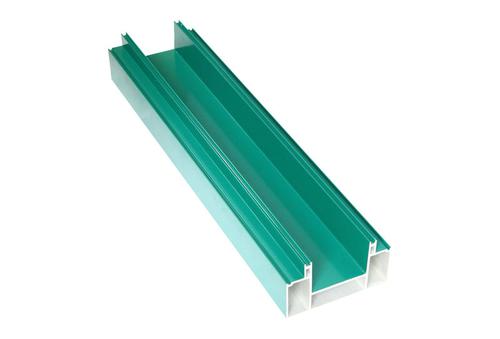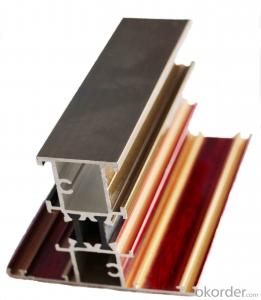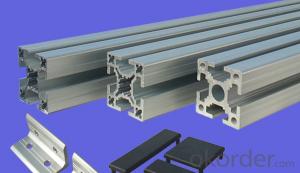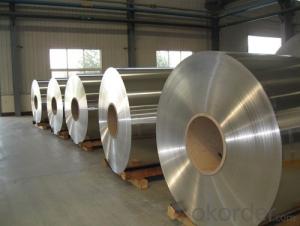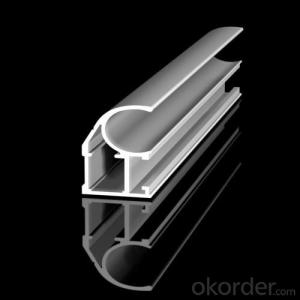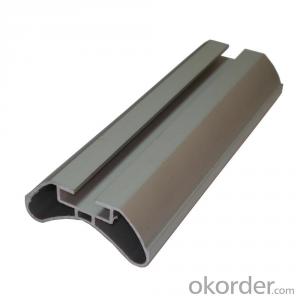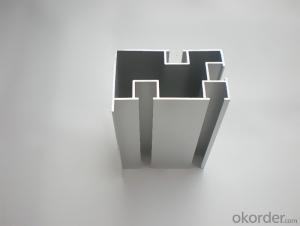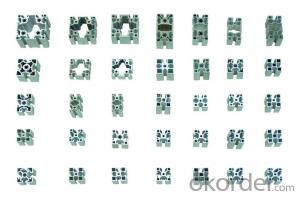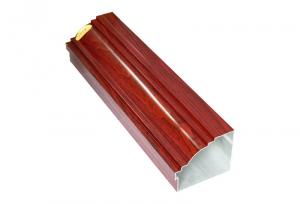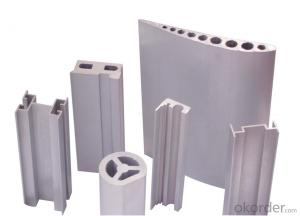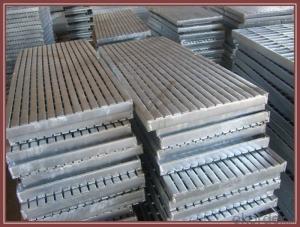Powder Coated T-Slot Aluminum Extrusion Profiles
- Loading Port:
- China Main Port
- Payment Terms:
- TT OR LC
- Min Order Qty:
- -
- Supply Capability:
- -
OKorder Service Pledge
OKorder Financial Service
You Might Also Like
POWDER COATED ALUMINUM PROFILE
Industrial aluminium profile
1)Material : 6063 6061 6060 and different aluminium alloy
2)Status:T4 T5 T6 or other special status
3)Surface treatment: mill finish, anodized sliver ,anodized bronze, anodized champagne, anodized black pearl, various power coating color, electrostatic sliver, electrostatic champagne, electrostatic golden, electrostatic titanium , machine polish sliver, machine polish bronze, wooden grain color, and Fluorocarbon spraying.
4)Annual capacity : 120000TON
5)Quality : China Nation Standard GB/T 5237 2008 (advanced class)
6)Use: can be widely using aluminium window, door, curtain wall, hand railing , normal aluminium profile, decorative and industrial aluminium profile
7)Advantage: Famous Brand reasonable&market price, soonest delivery and good after sale- service
8)Type of package:protection foam+heat contracted plastic film. / wooden packing / Metal pallet or depand on clientspecial requirement.
9)Payment term:T/T:30% of total value as deposite should paid by T/T within 3 days when confirmation ,and the remaining sum should be paid by T/T before delivery.L/C: 100% at sight
10)Delivery Day: 15-30days
11)Honor : CHINA FAMOUS TRADEMARK, CHINA TOP BRAND, ISO9001-2000, CHINA SQUARE&ROUND COMMITTEE DNV
- Q: What are the advantages of using aluminum profiles in window and door frames?
- There are several advantages of using aluminum profiles in window and door frames. Firstly, aluminum is a lightweight material, making it easier to handle during installation and maintenance. This makes the overall construction process more convenient and cost-effective. Secondly, aluminum is highly durable and resistant to corrosion, which ensures a longer lifespan for the window and door frames. Unlike other materials, such as wood or steel, aluminum does not rot, warp, or rust when exposed to moisture or extreme weather conditions. This durability translates to lower maintenance and replacement costs over time. Additionally, aluminum profiles offer excellent thermal insulation properties. They can be designed with thermal breaks or insulating materials, preventing heat or cold transfer between the interior and exterior of a building. This results in improved energy efficiency and reduced heating and cooling costs. Furthermore, aluminum profiles can be easily customized to fit various design requirements. They are available in a wide range of shapes, sizes, and finishes, allowing for flexibility in architectural designs. Whether it is a modern or traditional style, aluminum profiles can be tailored to meet specific aesthetic preferences. Moreover, aluminum is a sustainable and environmentally friendly material. It is 100% recyclable without losing its properties, making it a perfect choice for those concerned about reducing their carbon footprint. Lastly, aluminum profiles offer enhanced security features. They can be reinforced with additional locking mechanisms and impact-resistant glass, providing better protection against break-ins and ensuring the safety of the occupants. In conclusion, the advantages of using aluminum profiles in window and door frames include their lightweight nature, durability, thermal insulation properties, customization options, sustainability, and enhanced security features. Choosing aluminum profiles can result in long-term cost savings, energy efficiency, and aesthetic appeal for any building project.
- Q: How are the aluminum and aluminum sections joined?
- The frame structure is connected with special connecting pieces according to different specifications, and your graphic 40*40 can only be connected through an outer connecting piece. You can go to the profile dealer to purchase the relevant accessories.
- Q: How do aluminum profiles contribute to daylighting strategies?
- Aluminum profiles play a significant role in daylighting strategies by facilitating the efficient use of natural light in buildings. These profiles are used to create windows, skylights, and curtain wall systems, which allow for the maximum entry of sunlight into the interior spaces. One of the primary advantages of using aluminum profiles in daylighting strategies is their ability to support large glass panes. Aluminum is lightweight and structurally strong, enabling the creation of expansive glazing systems that maximize the transmission of natural light. These profiles can be designed to have slim sightlines, providing unobstructed views and allowing more sunlight to enter the building. Moreover, aluminum profiles can be thermally broken, meaning they have a layer of insulation between the interior and exterior aluminum sections. This thermal break prevents the transfer of heat and cold, improving the energy efficiency of the building. By minimizing thermal bridging, aluminum profiles contribute to reducing the loss of heat or cool air, resulting in lower energy consumption for heating and cooling systems. Additionally, aluminum profiles can be finished with various coatings that enhance their daylighting performance. For instance, reflective coatings can be applied to the profiles to redirect sunlight deeper into the interior, increasing the overall brightness of the space. Such coatings can also help reduce glare and control the intensity of sunlight, creating a more comfortable and visually pleasing environment. Furthermore, aluminum profiles offer flexibility in terms of design and customization. They can be shaped into different geometries and sizes, enabling architects to create innovative and unique daylighting solutions. For example, the profiles can be curved, angled, or combined with other materials to achieve specific aesthetic and functional requirements. In summary, aluminum profiles contribute to daylighting strategies by allowing for the efficient use of natural light in buildings. Through their structural strength, thermal performance, and customization possibilities, these profiles enable the creation of large glazing systems that maximize the entry of sunlight while maintaining energy efficiency and visual comfort.
- Q: The question asks if aluminum profiles can be tailored to fit particular specifications or needs.
- <p>Yes, aluminum profiles can be customized to meet specific requirements. This customization can include altering the length, shape, thickness, and surface treatment of the profiles to fit the needs of various applications. Manufacturers often offer a range of standard sizes and finishes, but they can also create bespoke profiles through processes like extrusion, cutting, and bending. Customization allows for the creation of precise fits and functional designs tailored to individual projects, enhancing both aesthetics and performance.</p>
- Q: What are the bending capabilities of aluminum profiles?
- Due to their inherent properties, aluminum profiles possess exceptional bending capabilities. Aluminum, being a highly malleable metal, can effortlessly assume various shapes without fracturing or breaking, making it an ideal choice for applications that necessitate complex bending or curving. The bending capabilities of aluminum profiles are predominantly influenced by the alloy employed and the specific shape or design being bent. Certain aluminum alloys, such as 6061 or 6063, are commonly utilized for extruded profiles due to their excellent bending properties. These alloys strike a good balance between strength and formability, making them well-suited for bending applications. To bend aluminum profiles, specialized machinery, like a bending machine or a press brake, is typically employed. The profile is meticulously positioned and clamped before pressure is applied to achieve the desired shape. The process can involve multiple passes to accomplish tight or gradual bends. Aluminum profiles can be bent to various angles, ranging from sharp bends to gentle curves, contingent upon the requirements of the application. The bending radius, denoting the minimum radius at which the profile can be bent without causing deformation, is dependent on the profile's thickness, alloy, and temper. Thinner profiles generally possess smaller bending radii compared to thicker ones. It is crucial to note that excessive bending or surpassing the material's capabilities can result in cracking or permanent deformation. Consequently, it is imperative to consider the specific bending requirements and seek guidance from experts or manufacturers to ensure adherence to proper bending techniques and limitations. In conclusion, aluminum profiles exhibit exceptional bending capabilities, facilitating the creation of intricate and customized shapes. Their versatility and formability have made them a favored option in industries such as construction, automotive, aerospace, and furniture manufacturing.
- Q: How do aluminum profiles perform in terms of electrical conductivity?
- Aluminum profiles have relatively low electrical conductivity compared to other metals such as copper or silver, but they still conduct electricity to some extent. They can be used for applications where moderate conductivity is required, but for high-performance electrical applications, other metals may be more suitable.
- Q: What's the difference between aluminum oxide and electrophoresis?
- Main features: 1 aluminum oxide) has strong abrasion resistance, weatherability and corrosion resistance. 2) can form a variety of colors on the surface of the substrate, the maximum for your requirements. 3) hardness, making it suitable for all kinds of buildings, industrial materials.Main features: 1 electrophoresis aluminum) has strong film hardness and strong impact resistance. 2) has very high adhesion of film, aging is not easy to fall off. 3) has better wear resistance, weather resistance and alkali resistance than aluminum oxide. 4) surface color is rich, beautiful, with a mirror like luster effect.Aluminum electrophoresis processing in oxidized aluminum on the basis of better quality than the oxidized aluminum chip. The price is a little better.
- Q: This question asks for a list of various fastening methods or components used to attach aluminum profiles in roofing systems.
- <p>In roofing systems, various types of fasteners are used to secure aluminum profiles, ensuring stability and longevity. Some common fasteners include: 1. Self-tapping screws, which thread directly into the aluminum without pre-drilling. 2. Rivets, which join two pieces of aluminum by compressing them together. 3. Nuts and bolts, used in conjunction with pre-drilled holes for a secure fit. 4. Clamps, which hold profiles together without penetrating the material. 5. Adhesives, used for bonding profiles in situations where mechanical fasteners are not suitable. 6. Clips and brackets, which can be used to attach profiles to other structural elements. Each type of fastener has its specific application and is chosen based on the design requirements and environmental conditions of the roofing system.</p>
- Q: The number of aluminum profiles can be meters or KG. How exactly is it? How do you understand that?
- You see the amount of it, if it is aluminum ingot is certainly in tons to calculate, the profile is, if it is a fixed size, usually 6 meters long.
- Q: What is the tolerance of aluminum profile extrusion?
- 2, precision extrusion technology requirementsIn general, the degree of Aluminum Alloy hot extrusion deformation, the influence of extrusion temperature and speed change, the extrusion equipment of neutral and die deformation are easy to profile precision, and their mutual influence factors is difficult to overcome. Figure 3 presents the factors affecting precision extrusion.3 、 requirements for toolingThe mold is the most direct factor to affect the product size precision extrusion, extrusion products to ensure that in the production section size or minor change, must make the mould rigidity, heat resistance, wear resistance can reach a certain requirement.First of all to ensure that the mold is not easy deformation under high temperature and high pressure, have very high heat resistance, the precision extrusion is more strict requirements in working temperature (500 degrees Celsius), the yield strength of the die material is not less than 1200N/mm2. then need to have high wear resistance, which mainly depends on the hardness and thickness of the nitrided layer. The general requirements of the hardness of the nitrided layer above 1150HV, depth of the nitrided layer between 0.25 mm and 0.45mm, and the changes after nitriding die size should be less than 0.02mm.For solid profile and hollow profile cantilever has cross section, but also consider the die elastic deformation, in order to make the mould to ensure certain rigidity, can be considered appropriate to increase the thickness of the mould with a special pad or similar shapes.Change control profile opening size, can be in the mold to control metal flow channel groove.
Send your message to us
Powder Coated T-Slot Aluminum Extrusion Profiles
- Loading Port:
- China Main Port
- Payment Terms:
- TT OR LC
- Min Order Qty:
- -
- Supply Capability:
- -
OKorder Service Pledge
OKorder Financial Service
Similar products
Hot products
Hot Searches
Related keywords



